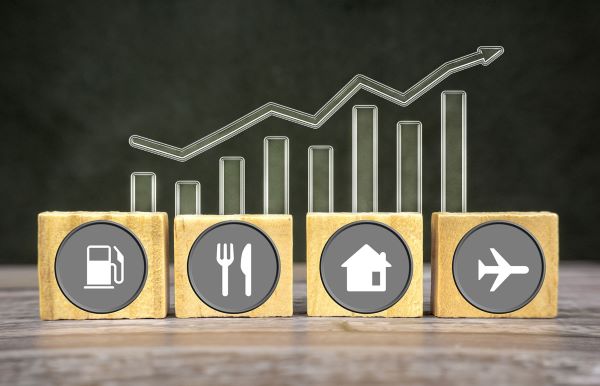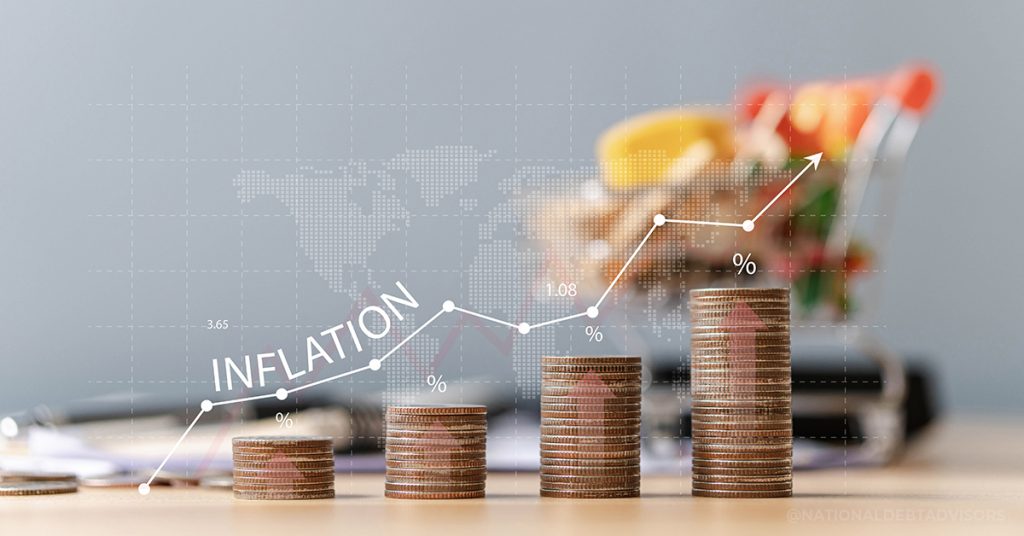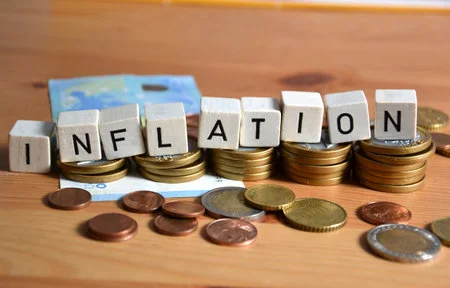Inflation is a term that is often heard in discussions about economic growth and the increase in prices over time. It refers to the rate of increase in the general level of prices for goods and services in an economy over a specific period. Inflation is usually measured through various indicators such as the consumer price index (CPI) or the producer price index (PPI). It is an important economic concept as it affects nearly all aspects of our daily lives, from the cost of groceries and fuel to the rates of investment returns and the prices of real assets. Understanding inflation and its different types, causes, and effects is vital for businesses, investors, policymakers, and individuals alike. In this article, we will explore the different aspects of inflation and provide insights into its impact on the overall economy.
Key Statistics and Facts
During periods of high inflation, businesses often utilize the last-in, first-out (LIFO) inventory cost valuation method. This means that the cost of the most recently purchased goods or materials is matched against revenue first, which can have significant implications for financial reporting and tax purposes.
Monitoring the CPI and PPI is crucial for understanding the impact of inflation on the economy. The CPI measures changes in the prices paid by urban consumers for a basket of goods and services, while the PPI tracks changes in the prices received by producers of goods and services. These indices provide valuable insights into the rate of price increases across various sectors.
The Federal Open Market Committee (FOMC) plays a vital role in managing inflation through its monetary policy decisions. One key tool is the federal fund’s target rate, which is the interest rate banks charge each other for short-term loans. Adjustments to this rate influence overall interest rates, impacting borrowing costs and consumption patterns, thereby affecting inflation levels.
Causes of Inflation
Inflation can occur due to various factors, each contributing to the overall increase in prices. One common cause is an increase in consumer demand, often driven by a growing economy and higher levels of disposable income. When demand outpaces supply, businesses may raise prices to accommodate the increased buying power of consumers. Additionally, supply chain issues, such as disruptions in production or distribution, can lead to shortages and higher costs, which are then passed on to consumers through price increases. Another significant cause of inflation is cost-push inflation, where rising input costs, such as wages or raw materials, force businesses to raise prices to maintain profit margins. Lastly, monetary and fiscal policies, such as an increase in the money supply or excessive government spending, can lead to an increase in the level of inflation. Understanding these causes is essential for policymakers and businesses to take appropriate measures to manage and mitigate the effects of inflation.

Demand-pull Inflation
Demand-pull inflation is a type of inflation that occurs when the demand for goods and services exceeds the current supply, leading to an increase in prices. This phenomenon is driven by factors such as increased consumer demand, government spending, or monetary policies.
When the demand for goods and services increases, businesses may struggle to keep up with the pace and fulfill all consumer needs. As a result, prices begin to rise as consumers compete for limited supplies. This increase in prices can lead to a decrease in purchasing power and a decrease in overall economic growth.
Demand-pull inflation can be triggered by various factors. For instance, if there is a sudden increase in consumer demand due to factors like population growth or changes in consumer preferences, businesses may not be able to increase their supply quickly enough to meet the surge in demand. Additionally, government spending, such as increased infrastructure projects or stimulus packages, can also contribute to demand-pull inflation by increasing aggregate demand.
Monetary policies implemented by central banks can also impact demand-pull inflation. If the central bank increases the money supply or lowers interest rates, it can stimulate consumer spending and lead to an increase in demand for goods and services. This, in turn, can cause prices to rise.
Demand-pull inflation occurs when the demand for goods and services outpaces the current supply, increasing prices. It can be caused by increased consumer demand, government spending, or monetary policies. Understanding the dynamics of demand-pull inflation is crucial for individuals and policymakers in managing the potential effects on the economy.
Cost-push Inflation
Cost-push inflation is another important concept to understand when discussing inflation. Unlike demand-pull inflation, which is driven by an increase in consumer demand, cost-push inflation occurs when the cost of production increases and businesses pass on these higher costs to consumers by raising prices.
One major factor that contributes to cost-push inflation is higher oil prices. When oil prices rise, it increases the cost of production for businesses that rely on oil as a key input. This could include transportation costs, energy costs, and the cost of raw materials derived from oil. As a result, businesses are forced to raise prices to maintain their profit margins, leading to inflationary pressures.
Currency depreciation is another factor that can contribute to cost-push inflation. When a country’s currency depreciates, the cost of importing goods increases. This is because it takes more of the local currency to purchase the same quantity of goods from abroad. As a result, businesses that rely on imported inputs face higher production costs, which they pass on to consumers through higher prices.
The negative impact of cost-push inflation on the economy is significant. As prices increase, consumers’ purchasing power decreases, leading to a decline in consumer demand. This can result in lower sales for businesses, which may lead to reduced production, layoffs, and economic slowdown. Furthermore, cost-push inflation erodes the value of wages, undermining workers’ real incomes and causing financial hardship.
Supply Chain Issues
Supply chain issues play a crucial role in understanding inflation and its effects on businesses. These issues can arise from disruptions in the flow of goods and services, such as delays in production, transportation bottlenecks, or shortages of raw materials. When supply chains are disrupted, companies may face challenges in procuring the necessary input materials to maintain their production processes.
During periods of inflation, companies often experience increased costs for these input materials. As prices rise, companies may have to pay more for raw materials, transportation, and other essential parts of their supply chain. To offset these losses and maintain profitability, businesses may be inclined to raise prices for consumers.
However, companies need to approach price increases thoughtfully. While it may be necessary to adjust prices to cover higher costs, it is equally important to consider the impact on customer relationships. Sudden or excessive price increases can erode customer loyalty and trust, potentially leading to decreased demand or even loss of market share.
To effectively ADAPT to inflation, businesses can take several steps. First, they should closely monitor their supply chains, identifying potential bottlenecks or vulnerabilities and finding alternative sources or strategies to mitigate disruptions. Second, companies should negotiate with suppliers to minimize price increases or seek more favorable terms. Third, businesses can focus on improving operational efficiency and cost control measures to minimize the impact of inflation on their bottom line. Lastly, companies should communicate transparently with customers, explaining the reasons for price adjustments and highlighting the value they continue to provide.
Effects of Inflation
Inflation can have a range of effects on an economy, businesses, and individuals. One of the most significant effects is the decrease in the purchasing power of money. As prices rise, each unit of currency can buy fewer goods and services, leading to a decline in the standard of living for individuals and increased costs for businesses. Inflation can also impact interest rates, with central banks often increasing rates to curb inflation. This can have implications for investment returns, bond prices, and real assets. Additionally, inflation can influence monetary and fiscal policies as governments aim to control and manage the effects of inflation on economic growth. Understanding the effects of inflation is crucial for businesses and individuals to navigate this economic phenomenon effectively and adapt their strategies to mitigate its negative impact.
On Economic Growth and Activity
Inflation, when moderate, can have a positive impact on economic growth and activity. It can be seen as a sign of a healthy, growing economy. Moderate inflation, typically measured by an increase in prices over some time, indicates that consumer demand for goods and services is strong and that businesses can increase their prices due to high demand.
Higher energy prices and supply chain issues can contribute to an inflationary environment. However, a moderate level of inflation is important for stimulating investment returns and maintaining the power of money over time. This is particularly true for real assets like stocks and bonds, which can act as a hedge against inflation by providing returns that pace with inflation or even outpace it.
On the other hand, low inflation can have negative effects on the economy. It can lead to decreased demand for goods and services as consumers delay purchases in the hope of lower prices in the future. This reduction in consumer spending can potentially lead to a recession.
An even more discouraging scenario is deflation, which refers to a sustained decrease in the general price level of goods and services. Deflation can be detrimental to lending and consumer spending, as individuals and businesses delay purchases in anticipation of further price decreases. This can further exacerbate economic downturns and lead to stagnant growth.
On Consumer Demand and Prices
Inflation, particularly in the form of cost-push inflation, can have a significant impact on consumer demand and prices. Cost-push inflation occurs when the cost of production increases, leading to higher prices for goods and services.
One of the factors that can contribute to cost-push inflation is higher oil prices. When the cost of oil rises, it impacts various sectors of the economy, including transportation and manufacturing. As a result, businesses face higher production costs, and they pass on these increased expenses to consumers through higher prices.
Additionally, currency depreciation can also contribute to cost-push inflation. When a country’s currency loses value, it becomes more expensive to import goods and materials. This, in turn, raises the cost of production and leads to price increases for consumers.
Several consumer goods and services are typically affected by inflation. For instance, the prices of used cars, furniture, airline fares, hotels, groceries, and gas can all be influenced by inflationary pressures. As production costs rise, manufacturers and service providers are compelled to adjust their prices accordingly.
One important consequence of inflation is the erosion of purchasing power. As prices rise, the same amount of money can buy fewer goods and services. This reduction in purchasing power can put a strain on consumer budgets and impact their overall demand for various products and services.
On Energy Prices & Supply Chains
Higher oil prices have a significant impact on global supply chains and energy prices. When oil prices increase, it acts as a “tax” on consumers and businesses, driving up costs across various sectors. This is because oil is a critical component in transportation, manufacturing, and energy production, making it a critical chokepoint in the supply chains.
The rise in oil prices not only affects the direct cost of energy but also ripples throughout the supply chains. As transportation costs increase, businesses face higher expenses for importing raw materials and distributing goods. These increased costs are eventually passed on to consumers through higher prices for various products and services.
Currently, the world is experiencing an energy crisis. Loss-making refineries, combined with a shortage of consumer fuels like diesel and gasoline, are contributing to the rising energy prices. This shortage is the result of a decrease in refining capacity and production disruptions caused by factors such as natural disasters and geopolitical tensions.
The impact of higher oil prices and the energy crisis is felt by consumers and businesses alike. Consumers face increased costs for transportation, heating, and everyday products influenced by energy prices. For businesses, higher energy costs translate into increased production costs and reduced profit margins.
Measurement of Inflation Rate
To understand the effects of inflation, it is crucial to have a reliable measurement of the inflation rate. It is an essential economic indicator that measures the purchasing power of money and reflects changes in the overall cost of living. Governments and central banks use various measures of inflation to gauge economic activity, assess the impact of monetary and fiscal policies, and make informed decisions. One commonly used measure of inflation is the consumer price index (CPI), which calculates the weighted average price of a basket of goods and services consumed by households. Another measure is the core inflation rate, which excludes volatile components like food and energy prices that can distort the overall inflation picture. Accurate measurement of the inflation rate helps individuals, businesses, and policymakers navigate inflationary environments and make informed financial decisions.

Consumer Price Index (CPI)
The Consumer Price Index (CPI) is a key economic indicator that measures the average consumer’s cost of living. It tracks the price changes of a basket of commonly purchased goods and services over time. The CPI is calculated by taking into account the prices of various items, such as food, transportation, healthcare, clothing, and entertainment, among others.
To determine the CPI, statistical agencies conduct household surveys to collect data on the expenditures of a representative sample of consumers. These surveys help identify the items purchased most frequently and the proportional weights assigned to those items in the consumer basket.
In the United States, housing expenses, including rent and mortgages, constitute the largest component of the consumer basket. This reflects the significant portion of income that households spend on housing costs. Consequently, changes in housing expenses have a substantial impact on the overall CPI.
The CPI is an essential tool for policymakers, businesses, and individuals in understanding the rate of inflation and its effects on the economy. It provides crucial information for making informed decisions regarding wages, investment returns, monetary and fiscal policies, and cost adjustments. By tracking the cost of living over time, the CPI helps assess how price increases impact consumers’ purchasing power and their ability to maintain their desired standard of living.
Core Inflation Rate Measurement
Core inflation rate measurement is an important tool used to monitor underlying trends in inflation by excluding certain volatile elements. It focuses on the overall price movement of goods and services, excluding items such as government-set prices and volatile food and energy prices. By excluding these factors, core inflation provides a more accurate representation of long-term inflationary pressures in the economy.
The exclusion of food and energy prices is primarily justified by their tendency to fluctuate significantly in response to supply chain issues and changes in global energy prices. By eliminating these temporary and unpredictable influences, core inflation allows policymakers to focus on the sustained increase in prices that may have a more lasting impact on economic activity.
Policymakers closely monitor core inflation as it offers valuable insights into the underlying inflationary environment. It helps them assess the effectiveness of monetary policy measures and make informed decisions to ensure price stability and sustainable economic growth. By relying on core inflation, policymakers can make more accurate assessments of the level of inflation and the appropriate policy responses needed to maintain a healthy economy.
Conclusion
In conclusion, understanding inflation is crucial for policymakers as it helps them gauge the rate of increase in prices, which can have significant effects on economic growth. By excluding food and energy prices, policymakers can focus on core inflation, which provides valuable insights into the underlying inflationary environment and allows for informed decision-making.

